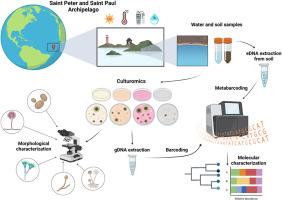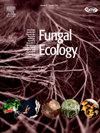The untapped fungal diversity of the Saint Peter and Saint Paul Archipelago, Mid-Atlantic Ridge, Brazil
IF 2.2
3区 环境科学与生态学
Q3 ECOLOGY
引用次数: 0
Abstract
The Saint Peter and Saint Paul Archipelago (SPSPA), located in the equatorial Atlantic Ocean, is a remote and extreme environment with high salinity, intense UV radiation, scarce vegetation, and limited nutrients. This study presents the first in-depth survey of its fungal communities using culturomics and metabarcoding. Thirty samples of soil, water, and organic matter were collected from ten sites. Culturomics yielded 313 isolates, with 204 fungi identified by DNA barcoding (internal transcribed spacer region sequencing). Most belonged to Ascomycota (90.7 %), with Aspergillus (14.7 %), Candida (13.7 %), and Hortaea (13.2 %) as dominant genera. Notably, 45 isolates (22 %) showed potential to represent new species, highlighting microbial adaptation to extreme conditions. Metabarcoding of three soil samples revealed 422 amplicon sequence variants, mainly from Ascomycota. This is the first intensive report of fungal communities from SPSPA, providing a foundation for future studies on biodiversity changes, as well as to explore potential biotechnological applications.

圣保罗群岛未开发的真菌多样性,大西洋中脊,巴西
圣彼得和圣保罗群岛(SPSPA)位于赤道大西洋,是一个偏远而极端的环境,盐度高,紫外线辐射强,植被稀少,营养物质有限。本研究首次使用培养组学和元条形码对其真菌群落进行了深入调查。从10个地点收集了30个土壤、水和有机物样本。培养组学鉴定出313株真菌,其中204株通过DNA条形码(内部转录间隔区测序)鉴定。以子囊菌门(90.7%)为主,优势属为曲霉(14.7%)、念珠菌(13.7%)和Hortaea(13.2%)。值得注意的是,45个分离株(22%)显示出代表新物种的潜力,突出了微生物对极端条件的适应。对3个土壤样品进行元条形码分析,发现422个扩增子序列变异,主要来自子囊菌门。这是SPSPA真菌群落的首次密集报道,为进一步研究生物多样性变化和探索潜在的生物技术应用奠定了基础。
本文章由计算机程序翻译,如有差异,请以英文原文为准。
求助全文
约1分钟内获得全文
求助全文
来源期刊

Fungal Ecology
环境科学-生态学
CiteScore
5.80
自引率
3.40%
发文量
51
审稿时长
3 months
期刊介绍:
Fungal Ecology publishes investigations into all aspects of fungal ecology, including the following (not exclusive): population dynamics; adaptation; evolution; role in ecosystem functioning, nutrient cycling, decomposition, carbon allocation; ecophysiology; intra- and inter-specific mycelial interactions, fungus-plant (pathogens, mycorrhizas, lichens, endophytes), fungus-invertebrate and fungus-microbe interaction; genomics and (evolutionary) genetics; conservation and biodiversity; remote sensing; bioremediation and biodegradation; quantitative and computational aspects - modelling, indicators, complexity, informatics. The usual prerequisites for publication will be originality, clarity, and significance as relevant to a better understanding of the ecology of fungi.
 求助内容:
求助内容: 应助结果提醒方式:
应助结果提醒方式:


